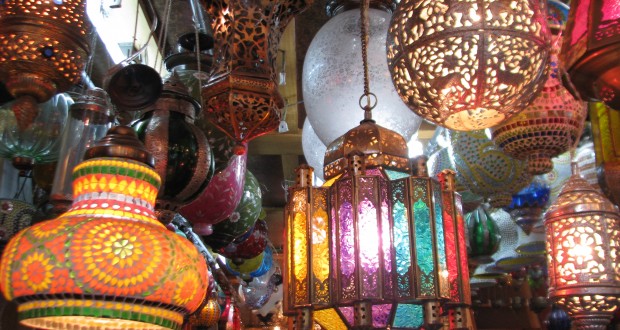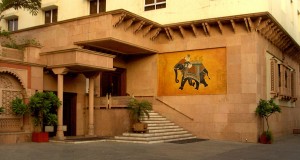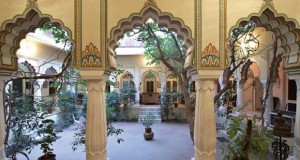Jaipur is a shopper’s paradise, even for Indian people. They come here from all over the country, to buy tie-and-dye bandhini bed linen, handwoven blankets, dhurrie, mirror-inlaid bangles, enamelled and blue pottery, gold and silver jewellery. Most of these things can be bought at reasonable prices at the many bazaars south of the old city, or at the several shops in Mirza Ismail (M. .) and Agra Roads. Bapu Bazaar and Nehru Bazaar are where to buy textiles, local perfumes and camel-skin shoes (Bap closed Sunday, Nehru Monday), and Johari Bazaar is the best place to window-shop for jewellery (here live most of the city’s silversmiths, goldsmiths and jewellers), to find traditional tie-and-dye saris and textiles, and to buy practically anything at much cheaper prices than high-street shops (closed Sunday, and Tuesday afternoons).
pottery, gold and silver jewellery. Most of these things can be bought at reasonable prices at the many bazaars south of the old city, or at the several shops in Mirza Ismail (M. .) and Agra Roads. Bapu Bazaar and Nehru Bazaar are where to buy textiles, local perfumes and camel-skin shoes (Bap closed Sunday, Nehru Monday), and Johari Bazaar is the best place to window-shop for jewellery (here live most of the city’s silversmiths, goldsmiths and jewellers), to find traditional tie-and-dye saris and textiles, and to buy practically anything at much cheaper prices than high-street shops (closed Sunday, and Tuesday afternoons).
Before hitting the markets though, make a visit to Rajasthan Government Handicrafts Emporium in M.I. Rd. This is a fixed-price place, open 8 am to 8 pin daily, where you see what’s available and how much it should cost. In a town like Jaipur, where hordes of tourists are ripped off daily, an hour or two spent here could save you a lot of money!
Jaipur’s best buys are gems and jewellery. This city is one of the centres of the jewellery industry in India, and attracts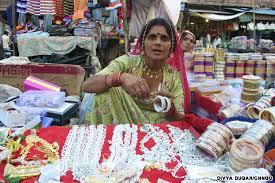 dealers from all over the world. Sapphires, emeralds, rubies, diamonds and every other kind of precious and semi-precious stone sell at a fraction of what they fetch when they get to Cartier or Tiffany. Gems are still mined in India, but roughstones are brought here to be processed from all over the world, because the craftsmen here can get a better yield. They examine and sort roughstones into three main categories: the clearest, finest stones, which are cut and polished into gems; the second-grade stones, which are made into necklaces and bracelets; and the lowest-quality which are generally ground down into powder, to furnish durable mineral paints and dyes for textiles and miniature paintings.
dealers from all over the world. Sapphires, emeralds, rubies, diamonds and every other kind of precious and semi-precious stone sell at a fraction of what they fetch when they get to Cartier or Tiffany. Gems are still mined in India, but roughstones are brought here to be processed from all over the world, because the craftsmen here can get a better yield. They examine and sort roughstones into three main categories: the clearest, finest stones, which are cut and polished into gems; the second-grade stones, which are made into necklaces and bracelets; and the lowest-quality which are generally ground down into powder, to furnish durable mineral paints and dyes for textiles and miniature paintings.
Jaipur has hundreds of gem ‘factories’,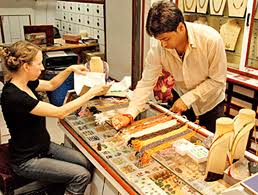 most of them located in the Parganj area off the old city (near Suraj Old Gate). These factories are usually small household concerns, run by families who polish and hand-cut the gems, then deliver them toe the ‘big man’ who oversees each area. The workers are generally children, who star their apprenticeship at about age 8 and are fully skilled by about 20. Watching then at work is a fascinating experience. To produce small gems, they glue the rough stone to the end of a long cane, which enables them to manoeuvre it easily while they Buse an electric rotating wheel to cut in the faces. To produce the facets on larger stones j they use a manual cutting-machine which resembles a saw.
most of them located in the Parganj area off the old city (near Suraj Old Gate). These factories are usually small household concerns, run by families who polish and hand-cut the gems, then deliver them toe the ‘big man’ who oversees each area. The workers are generally children, who star their apprenticeship at about age 8 and are fully skilled by about 20. Watching then at work is a fascinating experience. To produce small gems, they glue the rough stone to the end of a long cane, which enables them to manoeuvre it easily while they Buse an electric rotating wheel to cut in the faces. To produce the facets on larger stones j they use a manual cutting-machine which resembles a saw.
Nearly every street tout and rickshaw driver in Jaipur will try to steer you to a gem factory. They will tell you that you save 20-30% by buying ‘at source’ rather than at a high-street shop. Rickshaw men are the worst—insist (if you can) that they remain in their vehicle while you go shopping. If they get in the shop with you, expect to p. y 20-30% more, not less. Recently, as tourists have got wise to this con, touts have become more cunning.
f you must visit an emporium, at least go to a reliable one. The largest and best selection of loose stones and ready-made jewellery is at Gem Palace on Mirza Ismail R This is a treasure trove with everything from strands of garnets at Rs50 to a IV harajah’s collection of original Mughal pieces for a good deal more. You won’t make a killing here, but you’re not going to be ripped off. The same goes for the three ‘name’ jewellers in Johari Bazaar—D.Y. Durlabhji, Surana, and Ratnasangam—all of Which specialise in high-class gems, particularly emeralds. Jaipur is the emerald centre of the world. Unfortunately, the mark-up is fabulous. Before you buy an emerald ring in the UK, at least seven people have made money on it.
a reliable one. The largest and best selection of loose stones and ready-made jewellery is at Gem Palace on Mirza Ismail R This is a treasure trove with everything from strands of garnets at Rs50 to a IV harajah’s collection of original Mughal pieces for a good deal more. You won’t make a killing here, but you’re not going to be ripped off. The same goes for the three ‘name’ jewellers in Johari Bazaar—D.Y. Durlabhji, Surana, and Ratnasangam—all of Which specialise in high-class gems, particularly emeralds. Jaipur is the emerald centre of the world. Unfortunately, the mark-up is fabulous. Before you buy an emerald ring in the UK, at least seven people have made money on it.
Emeralds which .pw eart Dcauralta,e bahrjei ‘slo flodr l iRn sLl0o0n0don for at least five times as much. But if you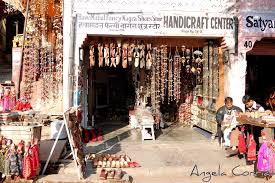 think you can, as a foreigner, buy cheap emeralds in Jaipur you’re Mistaken. You really have to know what you’re talking about. If you do, check out the mall alley between 264 and 268 Johari Bazaar. This is the recognised ‘gem centre’ of jaipur, where you can pick up all kinds of loose stones at rock-bottom prices. But you must know what you’re looking for. As soon as you enter the alley, you’re assaul ted by a scrum of urgent, insistent guys screaming ‘Buy my packetr !’.
think you can, as a foreigner, buy cheap emeralds in Jaipur you’re Mistaken. You really have to know what you’re talking about. If you do, check out the mall alley between 264 and 268 Johari Bazaar. This is the recognised ‘gem centre’ of jaipur, where you can pick up all kinds of loose stones at rock-bottom prices. But you must know what you’re looking for. As soon as you enter the alley, you’re assaul ted by a scrum of urgent, insistent guys screaming ‘Buy my packetr !’.
Their packets contain glittering arrays of random rough-cut stones, offered at low, low prices. Often, the reason why these guys are so urgent to sell (and why the gems are no cheap ) is that they are factory workers who have pocketed stones they’ve been w ing on and have to get rid of them in their lunch breaks. It’s an ideal market for jYneweler wohog hausome knowledge of gems, but even the average tourist can’t go far wrong—provided he or she makes no ‘offer’ until ready to buy. Once you’ve made an offer, you’ve got to buy. No offer should be made until you’ve had a good look at several packets, and have compared price and quality. When making your selection, bear in mind that these stones are not sized—you’ll have to pay extra later on, to have them made up into rings, necklaces, pendants, cufflinks etc. This is best done at a reputed jeweller like Beg Gems, Mehdika Chowk, Badi Chopa (near Wind Palace).
Actually , gem-buying is not as specialised a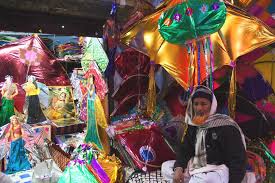 business as one might think. Following few basic rules, you’re bound to win. Take emeralds, for instance. Shades vary from ldighat grrenk. T het doarker and grener the stone is, more value is placed on II Next, look at its opaqueness. A transparent stone has more value than an opaque stone. But the ‘colour’ should be primarily clear, giving it ‘brilliance’. Next, you take eoyeuglta sy (soomuerthing which always impresestret-traders) and examine II the stone for ‘cut’. The cut should be even, and the number of ‘carats’ not less than IL 3. This means the stone will contain 125 facets, giving it a good colour and nature A stone with few facets will have little transparency, and this will detract magnificantly from its value. A lot of ‘street-cut’ jewellery is of dubious quality—with gems the facets may be uneven, the colour poor (look out for flecks and impurities), maany dev ent hbee unrseightly scratches and chips. You’re fairly safe with semis – precious stones, like garnets and lapis lazuli, but a number of the so-called emeralds should be able to detect any flecks, flaws and hairline cracks. Sometimes, you’ll come across a stone which is absolutely brilliant—no impurities whatsoever! In 99% of cases, it will be synthetic. Fortunately, however, the human eye is very accurate— given a choice of several rough stones, it will usually select the very best one.
business as one might think. Following few basic rules, you’re bound to win. Take emeralds, for instance. Shades vary from ldighat grrenk. T het doarker and grener the stone is, more value is placed on II Next, look at its opaqueness. A transparent stone has more value than an opaque stone. But the ‘colour’ should be primarily clear, giving it ‘brilliance’. Next, you take eoyeuglta sy (soomuerthing which always impresestret-traders) and examine II the stone for ‘cut’. The cut should be even, and the number of ‘carats’ not less than IL 3. This means the stone will contain 125 facets, giving it a good colour and nature A stone with few facets will have little transparency, and this will detract magnificantly from its value. A lot of ‘street-cut’ jewellery is of dubious quality—with gems the facets may be uneven, the colour poor (look out for flecks and impurities), maany dev ent hbee unrseightly scratches and chips. You’re fairly safe with semis – precious stones, like garnets and lapis lazuli, but a number of the so-called emeralds should be able to detect any flecks, flaws and hairline cracks. Sometimes, you’ll come across a stone which is absolutely brilliant—no impurities whatsoever! In 99% of cases, it will be synthetic. Fortunately, however, the human eye is very accurate— given a choice of several rough stones, it will usually select the very best one.
If you don’t trust your judgement, nip over to the Gem Testing Laboratory off M.I. Rd (near New Gate), where for a nominal sum (around Rs25) you can have your purchases verified and valued. Steer clear of diamonds, by the way—they must be paid for in foreign currency, carry special setting restrictions, and require an export certificate. Silver is excellent value in Jaipur. You should, however, never pay over the bullion price per gram for silver bangles—they rarely have over 50% silver content. For a reliable shop, try Balaji Silvercraft, 102 Siredeori Bazaar (just off Johari Bazaar). Otherwise, check out the silver market in Johari Bazaar, or wander round the (innumerable) silver shops in Choti Chopa square. Forget about buying gold—it’s even more expensive in India than in Europe.
over to the Gem Testing Laboratory off M.I. Rd (near New Gate), where for a nominal sum (around Rs25) you can have your purchases verified and valued. Steer clear of diamonds, by the way—they must be paid for in foreign currency, carry special setting restrictions, and require an export certificate. Silver is excellent value in Jaipur. You should, however, never pay over the bullion price per gram for silver bangles—they rarely have over 50% silver content. For a reliable shop, try Balaji Silvercraft, 102 Siredeori Bazaar (just off Johari Bazaar). Otherwise, check out the silver market in Johari Bazaar, or wander round the (innumerable) silver shops in Choti Chopa square. Forget about buying gold—it’s even more expensive in India than in Europe.
Other popular buys in Jaipur are Persian-style carpets, stone carvings and Krishna-art miniature paintings. One look in  the government arts emporium is all it takes to convince you that prices are too high. You’ll find cheaper, better carpets in Pushkar and Jaisalmer, and miniature paintings in Udaipur. Jaipur does, however, have a good name for saris, fabrics and bed-linen. Kadar Bux Patel, 10 Havamahal (beyond Johari Bazaar), sells featherlight cotton quilts— the traditional winter bedding of the region—at Rs250 single-size, Rs500 doublesize.
the government arts emporium is all it takes to convince you that prices are too high. You’ll find cheaper, better carpets in Pushkar and Jaisalmer, and miniature paintings in Udaipur. Jaipur does, however, have a good name for saris, fabrics and bed-linen. Kadar Bux Patel, 10 Havamahal (beyond Johari Bazaar), sells featherlight cotton quilts— the traditional winter bedding of the region—at Rs250 single-size, Rs500 doublesize.
Similar quilts can be found at Anokhi, 2 Tilak Marg, but in a much greater variety of colours and designs, with prices from Rs450. They also stock a mass of interior furnishings and fine-quality cotton clothes at ridiculously low prices—unique cotton appliquéd bedcovers from Rs550, dresses from about Rs180. Over at Kin Fabrics, Station Rd, you can pick up atanisookh—quilted dressing gowns once worn by the maharajahs—from Rs350. Also kotah doria muslin—fine handloomed cotton, sometimes studded discreetly with tiny rhinestones or delicately threaded with gold—at Rs240 for the plain lengths, and between Rs400 and 600 for the decorated pieces.

